COUNTRY LINES



Almost every backyard has a shrine to cold air. It’s called an a/c unit. WaterFurnace will help you take back that space.

Air conditioners are unsightly and often located in the worst places. They’re vulnerable to the elements and can become home for small critters. But with geothermal, you won’t have an outside unit or any of these problems. So, reclaim your backyard. Plant some flowers and enjoy the unseen beauty that is WaterFurnace. Geothermal is the only renewable that provides reliable operation 24 hours a day, 7 days a week, 365 days a year.
Allendale
Allendale Htg & Clg (800) 327-1937 allendaleheating.com
Bad Axe/Ubly
Cutting Edge Htg & Clg (989) 551-0986
Berrien Springs
Waterfurnace Michiana (269) 473-5667 gogreenmichgeo thermal.com
Big Rapids Stratz Htg & Clg, Inc. (231) 796-3717 stratzgeocomfort.com
Clifford Orton Refrig & Htg (989) 761-7691 sanduskygeothermal.com

Hart Adams Htg & Clg (231) 873-2665
adamsheating cooling.com
Indian River
M&M Plmb & Htg (231) 238-7201 mm-plumbing.com
Lansing Candor Mechanical (517) 920-0890 candormechanical.com
Lowell Arctic Inc. Htg. & Clg. (616) 897-4213 heatingcoolingonline.com
Mancelona Top Notch Htg, Clg, & Geothermal (231) 350-8052 Topnotchheatandair.com
Michigan Center Comfort 1/Air Serv of Southern Michigan (517) 764-1500 airserv.com/southernmichigan/
Mt Pleasant Walton Htg & Clg (989) 772-4822 waltonheating.com
Muskegon Adams Htg & Clg (231) 873-2665 adamsheatingcooling.co
Portland
ESI Htg & Clg (517) 647-6906 esiheating.com
Sunfield
Mark Woodman Plmb & Htg (517) 886-1138 mwphonline.com
Traverse City
D&W Mechanical (231) 941-1251 dwmechanical.com
Geofurnace Htg & Clg (231) 943-1000 geofurnace.com
CO-OP REBATE INCENTIVES
Cloverland: up to $4,200
Great Lakes: up to $3,000
Homeworks/Tri-County: up to $3,000
Presque Isle: up to $2,700
Cherryland: up to $2,500
Thumb Electric: up to $2,000
Alger Delta: up to $2,000

EXECUTIVE EDITOR: Casey Clark
EDITOR: Christine Dorr

GRAPHIC DESIGNER: Karreen Bird
RECIPE EDITOR: Christin McKamey
COPY EDITOR: Yvette Pecha
CONTRIBUTING EDITOR: Emily Haines Lloyd
PUBLISHER: Michigan Electric Cooperative Association
Michigan Country Lines, USPS-591-710, is published monthly, except August and December, with periodicals postage paid at Lansing, Mich., and additional offices. It is the official publication of the Michigan Electric Cooperative Association, 201 Townsend St., Suite 900, Lansing, MI 48933.
Subscriptions are authorized for members of Alger Delta, Cherryland, Great Lakes, HomeWorks Tri-County, Midwest Energy & Communications, Ontonagon, Presque Isle, and Thumb electric cooperatives by their boards of directors.
Postmaster: Send all UAA to CFS.
Association Officers: Tom Sobeck, Presque Isle Electric & Gas Co-op, chairman; Gabe Schneider, Cherryland Electric Cooperative, vice chairman; Chris O’Neill, HomeWorks TriCounty Cooperative, secretary-treasurer; Craig Borr, president and CEO.
CONTACT US/LETTERS TO EDITOR:
Michigan Country Lines
201 Townsend St., Suite 900 Lansing, MI 48933 248-534-7358 editor@countrylines.com

CHANGE OF ADDRESS: Please notify your electric cooperative. See page 4 for contact information.
The appearance of advertising does not constitute an endorsement of the products or services advertised.
6 AMERICA’S BEST CAMPGROUND IS RIGHT HERE IN MICHIGAN
After staying at 350-plus RV parks, Terrell and Katie Deppe applied their experience to develop the award-winning Indian River RV Resort.
10 MY CO-OP KITCHEN
One-Pan Meals: These delicious dinners make cleanup a breeze.
14 THE GREAT LAKES SHIPWRECK MUSEUM PRESERVES MICHIGAN’S RICH MARITIME HISTORY
The recently found wreck of the Nucleus adds to the museum’s many discoveries.
18 GUEST COLUMN

At One with Plants: Inheriting his grandmother’s love of horticulture, Gary Bopp made gardening his passion and his career.
#micoopcommunity Instagram contest winner Morning glow @chelseaolkowski (Chelsea Olkowski)
To enter contests, submit reader content & more, visit countrylines.com/community
Instagram Contest
Use #micoopcommunity for a chance to be featured here and on our Instagram account.
Win $100 for photos published!
Recipe Contest
See details on page 10. Pumpkin recipes due Aug.1; Family Favorites due Sept. 1
Win a $100 bill credit!
Guest Column
Share your fondest memories and stories. Win $200 for stories published. Visit countrylines.com/ community to submit.
Win $200 for stories published!
Mystery Photo
See details on page 18. Win a $100 bill credit!
Charles Arbour
23899 M32 S, Hillman MI 49746
989-657-4358 • Term Expires: 2023
Allan Berg, Vice-Chairman
8400 Lost Lake Rd., Hawks, MI 49743
989-734-0044 • Term Expires 2023
Sandy Borowicz, Secretary 5341 Carlson Rd.,Cheboygan, MI 49721
231-627-9220 • Term Expires 2024
John Brown, Chairman 21 W. Devereaux Lake Rd., Indian River, MI 49749
231-625-2099 • Term Expires 2023
Sally Knopf
1849 W. 638 Hwy., Rogers City, MI 49779
989-734-4196 • Term Expires 2024
Kurt Krajniak 7630 Wallace Rd., Alpena, MI 49707
989-884-3037 • Term Expires 2025
Brentt Lucas 15841 Carr Rd., Posen, MI 49776
989-766-3678 • Term Expires 2025
Daryl Peterson, Treasurer
P.O. Box 54, Hillman, MI 49746
989-742-3145 • Term Expires 2024
Raymond Wozniak
6737 State St., Posen, MI 49776
989-766-2498 • Term Expires 2025
President & CEO: Thomas J. Sobeck tsobeck@pieg.com

Communications Director/Co-op Editor: Mairè Chagnon-Hazelman
Presque Isle Electric & Gas Co-op
3149 Main Street (M-211)
Onaway, MI 49765
Business Office & Billing: 989-733-8515
Toll-Free: 800-423-6634
Gas Emergency Toll-Free: 800-655-8565
PIE&G natural gas rates and charges are not regulated by the Michigan Public Service Commission.
Presque Isle Electric & Gas Co-op is an equal opportunity provider and employer.
It seems every year around this time, I get excited for long days, warm temperatures, and sitting by campfires. This year is no different. It’s a great time to rest up and enjoy the best that summer in our corner of the world has to offer. We’ve been quite busy at your cooperative for several years now, and our employees are looking forward to spending some welldeserved time in the sun. I hope you all get to enjoy some rest and relaxation time as well.
Summer also means it’s time to start working on the long list of seasonal “to-do’s” that we can’t do during the winter months. I would like to remind everyone of a few safety tips while you’re working on your projects. If you’re doing any digging at all on or around your property, please use the Miss Dig system. You can either call 1-800-MISS-DIG or submit your request online at oca.missdig811.org. Hitting underground utilities can be very dangerous (even deadly) and very expensive to repair. Since you are liable for the cost of repair, if you have any doubt about what is located underground, please call and have the utility companies mark their underground facilities before you begin your project.
If instead, you’re looking to finally cut that tree down that has been bothering you for a few years, take a minute to locate any overhead utility lines. Make sure there is no risk of the tree falling onto and striking those lines and causing damage. If there’s any chance of that happening, please give us a call first! We will review your situation and suggest the best way to take care of it. If necessary, we’ll send a crew to de-energize the lines while the work is being done. Please allow at least three business days prior to your project start.
The phone call you make to prepare for either of these situations is the safest and least expensive way to check those yardwork chores off your list. Please don’t assume you can take care of it. If there is any doubt, call!
Let’s all make sure this summer is a safe one filled with memories of gatherings at the cottage or around a campfire somewhere.
At its most recent meetings, the PIE&G Board of Directors…
• Revised the 2023 Annual Meeting location to the Posen High School on Oct. 27 at 10 a.m., due to a scheduling conflict at Onaway High School.
• Appointed members to the 2023 nominating committee.
• Reviewed the Communities First Fund audit presentation from SOME CPAS.
• Reviewed the 10-year financial forecast for all three divisions of the cooperative.
• Approved Resolution 2023-08 acknowledging the retirement of Lineman Mark Pomranke after 38 years of service to the cooperative.
• Accepted Team Reports.
Many of us are spending more time at home and finding new, creative ways to enhance our living space. Tackling do-it-yourself (DIY) projects for the home can be fun and cost-effective, so why not roll up those sleeves and get started! Whether you’re painting the front door with a fresh hue or finally upgrading those patio lights, successfully completing a DIY home project is incredibly satisfying. But many of these projects do not come without risks. Here are a few safety tips to keep in mind as you get to work.

Start by selecting a designated work area.
The amount of space you’ll need will depend on the size and scope of your project, but make sure you have adequate lighting and ventilation (if necessary). Required tools and equipment should be located in your workspace and organized for easy access.
We know you’re a pro, but investing a few bucks in PPE is essential for most home projects. Stock up on safety goggles, dust masks, earplugs (or noise reduction ear protectors), gloves, and any other kind of protection you’ll need for your project. Remember to wear appropriate clothing and shoes. (Ditch the sandals for this!)
When you rush through a DIY project, you’ll likely end up with less desirable results than you intended, or worse, you could make a costly or dangerous mistake. Take your time and remember that you are in control of the project. It would be best if you also clean as you go to ensure a safer workspace. Pick up any scrap materials, tools that aren’t in use, and any tripping hazards.
Be cautious with power tools. Annually, 8% of electrocutions in the U.S. are attributed to improper use of power tools. The Electrical Safety Foundation International offers the following safety tips:
• Use ground fault circuit interrupters (GFCIs) with every power tool to protect against electrical shock.
• Never use power tools near live electrical wires or water pipes.
• Use extreme caution when cutting or drilling into walls where electrical wires or water pipes could be accidentally touched or penetrated.
• If a power tool trips a safety device while in use, take the tool to a manufacturer-authorized repair center for service.
• Do not use power tools without the proper guards.
• When using a wet-dry vacuum cleaner or a pressure washer, follow the manufacturer’s instructions to avoid electrical shock.
Remember, you should only tackle DIY home projects within your skill and comfort level. We strongly recommend you hire a licensed, qualified electrician for assistance for projects that require extensive electrical work.
Once upon a time, in the middle of the woods, there was an RV park. It was neither too little nor too big. Neither too old nor too modern. Neither too remote nor too busy. It was, as our friend Goldilocks would say—just right. It was that “just rightness” that was likely the key to Indian River RV Resort being named Campspot’s 2023 Best Campground in America.
The story of any business, even one as charming as Indian River’s, is never a picture-perfect fairy tale. The owners of the RV park are Terrell and Katie
Deppe, who had no intention of buying an RV resort, or even an RV, until 2007. Terrell had taken a job in the tech industry, leading the couple to sell their home in Texas and move to Minnesota. The market had been good for home sales, but the couple was hesitant to pay the high prices the buyers’ market was asking. So, they rented, moving twice. During one of their transitions, Terrell, who was able to work remotely, was struck with an idea.
“I looked at Katie and said, ‘If we are going to have to keep moving, let’s just KEEP moving. Let’s buy an RV,’”
To learn more about Indian River RV Resort or to book a lot at the Best Campground in America, visit:

said Terrell. “It took her a while to wrap her head around the idea, but when she realized that the amount of money we were spending on rent and moving could pay for the depreciation of an RV in less than a year, she committed to 10 months.”
Ten months turned into five years during which the Deppes traveled to 46 of the lower 48 states in the U.S. and stayed in over 350 private, state, and national RV parks. They experienced the best and worst of them and were getting a feel for what worked and what didn’t in their nomadic lifestyle.
For the next decade, the Deppes began looking for an opportunity to take the knowledge they’d gained on the road and put that, along with their passion and grit, into an RV park of their own. That’s when Indian River RV Resort came into their lives. Finally, at the end of 2019, they had made an offer and were prepared to take on the challenges of owning an RV park— maybe not the sort of challenges they were about to face.

“I quit my job on Friday, March 13, and the country shut down on Monday,
March 16,” said Terrell, referencing the COVID-19 pandemic. “Had we just made the greatest mistake of our lives, or was God going to lead us to our promised land? We chose to act in faith.”
The Deppes went to the park to help the current owners open for the season—getting their hands into daily operations, waiting for the sale to close, and preparing for the July Fourth weekend.


While much of the world had seemed to shut down, folks were still eager to travel with their families, and one of the few things open was the great outdoors.
“We were receiving an average of one call per minute, not counting the people standing in front of us to book future dates,” said Terrell. “We were using the resort’s previous paperbased reservation system. It felt like we were failing, and we had to make some big changes—fast.”
Luckily, Terrell’s experience in tech and the multitasking wizardry Katie had developed while home-schooling the couple’s four children were the
perfect skill set for the challenges they faced. They quickly switched to an online reservation system and were able to focus on creating a clean, quiet, family-friendly space similar to the ones they had enjoyed on their own RV travels.
Now the Deppes, along with their son Jonathan, turn their attention to maintaining the gorgeous land, keeping the facilities pristine and welcoming, and dreaming up ways to improve their guests’ experience. They often go above and beyond. One of their most recent projects was consulting with a certified master arborist about the well-being of their trees. With the findings, they swapped ground leaf removal for mulching and are already seeing healthier grounds. It’s this sort of attention to detail that allows their guests to let the busyness of the world fall away. It’s just the sort of thing you hope for when you head out to escape the dragons of the world and find yourself, for a time at least, living happily ever after.

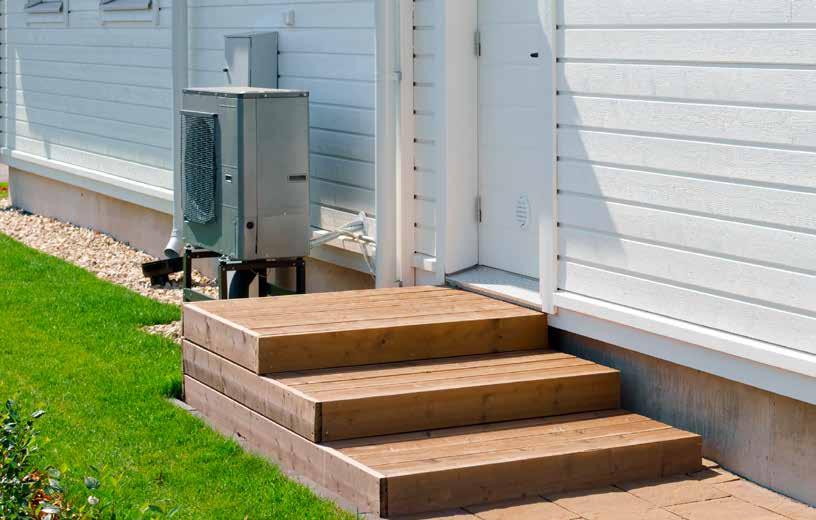

While you might be focused on trying to stay cool in July and August, investing in a heat pump for your home might just be the ticket to help you save on energy costs this summer—yes, even cooling costs. Air-source heat pumps are a great solution if you are looking to replace your heating or cooling system in your home, all while helping you save energy (and money!).
What is a heat pump?
Heat pumps use electricity to move heat, rather than to generate it, like an electric or gas-powered furnace would. In the summertime, this means moving the heat from inside your home to the outside.
But heat pumps don’t just offer benefits in the summertime. They’re more efficient in the winter as well, using less energy to heat your home. Even if you aren’t looking to replace your heating and cooling system,
installing a heat pump can help you offset some of the operating costs of your existing heating system during the colder months.
Installing a heat pump means having peace of mind when it comes to the health and safety of your home environment. This can look like:
• Less risk of leaks, fires, and carbon monoxide poisoning heat pumps are not powered by natural gas or propane.
• Clean indoor air —heat pumps have an air filter that removes harmful particles, and many models also provide dehumidification, decreasing the risk of mold and mildew.
• More consistent temperatures in your home.
Incentives start at $1,000 for heat pumps from the PIE&G Energy Optimization program!
There is a wide variety of incentives for heat pumps and other HVAC equipment available from the Energy Optimization program. For a complete list, visit pieg.com/eo or call 877-296-4319


Enter to win up to a $50 energy bill credit!

Submit Your “Everything Fall” Photos
By July 20!
Submit your best photo and encourage others to vote! The photo receiving the most votes in our photo contest will be printed in an issue of Country Lines, along with some of our other favorites. Our July/Aug. theme is Everything Fall Photos can be submitted through July 20 to be featured in our September issue.
To enter the contest, visit pieg.com/photocontest. Enter your picture, cast your vote, and encourage others to vote for you as well. If your photo is printed in Country Lines during 2023, you will be entered into a drawing for a chance to win one of four $50 credits on your January 2024 bill.

2. Winter camping in Royston, Michigan. With three campers, it was a fun time! One was rustic camping with a tarp, one with a standard tent set up, and one with a tent and heater. Brandy Shooks
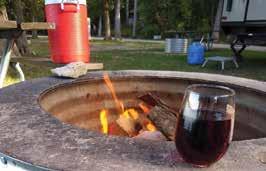
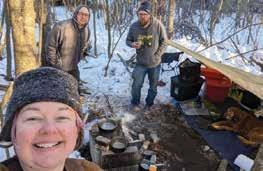
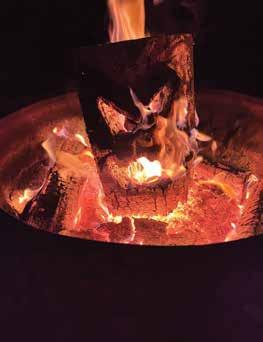
3. We camped in Grand Marais, Michigan. Strolled around by Pictured Rocks and captured this beautiful scene. Carrie Trombley

4. A little extracurricular activity while glamping near Hillman’s Long Lake. Our only concern was the “Beware of the Lake Association” sign nearby. Good thing for camo! :-) Michael Lavens

Win a $100 energy bill credit!
Pumpkin recipes due Aug.1; Family Favorites due Sept. 1

Submit your favorite recipe for a chance to win a $100 bill credit and have your recipe featured in Country Lines with a photo and a video. Submit your recipe at micoopkitchen.com , or send it via email (include your full name and co-op) to recipes@countrylines.com
WINNING
Jean Horrocks, Presque Isle Electric
1 pound ground beef
2 (15-ounce) cans diced tomatoes
1 (15-ounce) can tomato sauce
8 ounces (2 cups) uncooked elbow macaroni
½ cup chopped onion
1 medium green bell pepper, diced
1 tablespoon sugar
1 teaspoon chili powder (or to taste)
2 teaspoons salt
1 cup sour cream
• water, as needed
Brown meat in large skillet. Drain off all the fat as it collects. Stir in remaining ingredients, except sour cream. Add ¾ to 1 cup water and stir. Heat to boiling. Cover and simmer 20–25 minutes, stirring frequently. Add additional water if mixture is too thick. Cook just until noodles start to soften, then stir in sour cream; heat through but do not boil. Makes 6 servings.
Watch a video of this month’s winning recipe at micoopkitchen.com/recipe_ type/videos/

Shanasee Tersigni, Presque Isle Electric
1 teaspoon grapeseed oil
1 medium yellow onion, diced
4 cloves black or regular garlic
1 cup fennel, chopped (with fronds)
¼ –½ teaspoon pink Himalayan salt
¼ –½ teaspoon freshly ground black pepper
1 teaspoon Calabrian chili flakes or red chili flakes
1 sprig rosemary leaf
1 handful chopped fresh oregano
1 pound ground venison
2 zucchini, peeled and chopped
1 cup morel mushrooms
2 cups chopped kale
1 can (15-ounce) Italian stewed
tomatoes
2 cups organic chicken bone broth
2 cups low sodium V8
1 (8- ounce) box quinoa elbow
pasta, or favorite pasta noodles
1 (15.5- ounce) can cannelini
beans
1 (15.5- ounce) can dark red kidney beans
½ cup Peppadew peppers (a pickled piquant pepper) (substitute with sweet cherry peppers, sweet drop peppers, pimentos, sweet red peppers, or pepperoncini) & splash of pickling liquid from jar
• fresh basil and lemon zest, for garnishing
Heat ceramic cast iron pot to medium heat. Add oil. Sauté onions, garlic, fennel, salt, and pepper. Cook until onion and fennel are tender. Add herbs and ground venison. Cook until meat is browned. Add zucchini, morels, and kale. Sauté a minute, stirring. Add all remaining ingredients. Cook until pasta is al dente. Add additional broth or vegetable juice if needed. Garnish with fresh basil and lemon zest. Season to taste.

Linda Heintz, Great Lakes Energy
2 tablespoons olive oil
1 pound uncooked chicken breast, cut into ¼-inch slices
1 small sweet onion, cut into chunks
1 small red onion, cut into chunks
8 ounces sliced mushrooms
1 cup small broccoli florets
1 cup small cauliflower florets
1 cup chicken broth
½ pound asparagus, sliced into 2-inch pieces
1 cup pea pods, strings removed
¼ cup soy sauce
2 tablespoons cornstarch
½ teaspoon salt
½ teaspoon sugar
• green onions, sliced
Heat oil in large wok over medium-high heat. Add sliced chicken and sauté until no longer pink. Add onions, mushrooms, broccoli, and cauliflower. Sauté until just beginning to get tender, 3 to 4 minutes. Add 1 cup of broth, put lid on pan and simmer for 2 minutes. Remove lid, then add asparagus and pea pods. Sauté until just beginning to soften and color turns bright. Mix together soy sauce, cornstarch, salt, and sugar. Add soy sauce mixture to pan and stir quickly. Continue to stir in all liquids and ingredients as sauce thickens. Can also sprinkle sliced green onions on top when finished. Serve alone or over rice. I use this same recipe with venison steak and use beef broth instead of chicken broth. You can use any vegetables you have on hand, but save the ones that cook quickly for the time period after the 2-minute simmer.

4 bone-in skinless chicken breasts, quartered
• salt & pepper
½ cup flour
2 cups extra virgin olive oil
1 large onion, diced
4 cloves garlic, minced
2 cups white wine
1 (5- ounce) jar Spanish green olives, sliced with pimento
1 teaspoon cinnamon
Salt and pepper chicken breasts and then dredge in flour. Heat olive oil in skillet and fry chicken until crisp
on both sides but not fully cooked. Remove chicken from skillet and pour out all but a ¼ cup of the olive oil. Turn temperature to medium. Add onions and cook for about 3 minutes until translucent. Add garlic and cook for about 1 minute, turning. Add white wine and let cook down until reduced by half. Add olives and roughly 4 tablespoons of juice from the jar. Add the cinnamon and stir. Add the chicken and put a lid on. Simmer for 30 minutes. Best if served over longgrain rice.
Lynn Hagon, Great Lakes Energy
1 pound hamburger
1 (15-ounce) can vegetable soup

1 (15-ounce) can tomato soup
2 cups water
3–4 carrots, cut up
2 medium potatoes, cut up
1 small onion, chopped
Brown hamburger and onion; drain. Add soups, water, and vegetables. Cook for about 45 minutes or so.
Kim Schumacher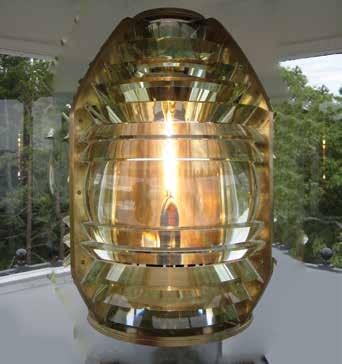
There is perhaps no structure as universally adored as the lighthouse. Whatever the reason—be it their place in history, their iconic architecture, or the fact that they embody safety and strength—these landmarks tend to inspire and intrigue us.
In Michigan, we are lucky enough to have more lighthouses than any other state, many of which can be found right here in the PIE&G service area. One of them is the 40 Mile Point Lighthouse near Rogers City. It was built in 1896 and was an important piece of the Great Lakes shipping industry, but over time, as often happens with lighthouses, it began to fall into disarray. In 1996, the lighthouse was assigned for disposal. That’s when Presque Isle County, which already deeded the surrounding property, applied to also have jurisdiction of the lighthouse. That request was granted in 1998, and since then, county officials have been working alongside the 40 Mile Point Lighthouse Society to restore the entire light station.
Pat Williams is the vice president of the society, with which he and his wife Shawn have been involved for many years. As a child, Shawn spent summers vacationing with her family in a cottage a half mile from the lighthouse. It made a lasting impression on her, and when she and Pat retired, they moved into the cottage and renovated it into a house.
“When we moved here, we already loved the lighthouse and would visit often,” Pat said. “So people in the society said, ‘oh, maybe you could come and volunteer,’ and that just naturally progressed into us having more and more to do with it.” The Williamses, PIE&G members, have pitched in just about every regard, but these days, Pat mostly handles the website and is about to take over the Guest Keepers program. Shawn (the society’s secretary) runs the
gift shop, which Pat says is one of the busiest volunteer jobs. “Admission to the park is free, so the gift shop is our means of defraying the cost of keeping the lighthouse open,” he said.
The grounds of the lighthouse tower are comprised of just under 40 acres that also house the gift shop, the old Glawe one-room schoolhouse, a fog signal building, and a pilot house. Additionally, there are several hiking trails, a campground, a chicken coop, and the park’s large, shallow
 Fresnel Lens
Fresnel Lens
beach, where visitors can swim, kayak, or paddleboard. The beach offers a view of the wreckage of the Joseph S. Fay, a schooner that ran aground in 1905 during a snowstorm. Part of the ship is on the beach itself, while part of it can be seen by divers and snorkelers under about 15 feet of water.
The lighthouse tower is a duplex building with a museum on one side of it and living quarters for the groundskeeper’s family on the other. Pat says much of what you see in the lighthouse is original, including white ash floors and woodwork. He says it’s been fully kept in the style of the 1920s and ‘30s. “The furnishings are period-correct,” he said. “You’ll see the sewing machines and looms reminiscent of what keepers would work with in that day.”
Pat says that while visitors really enjoy seeing what lighthouse life used to look like, they are allowed to do more than look. “We’re a bit unique in that if someone wants to touch the tableware or open a door, we don’t discourage it. It’s not the type of place where everything is behind glass or roped off. We want them to look at something up close and ask, ’What was this for?’”
One notable exception to this carefree approach is in the tower of the lighthouse. “The county owns the lighthouse, but the Coast Guard owns the light itself,” Pat said. “They want to keep people from touching the lens, so there is always a docent present.” The lens is an important part of the light station’s history. Only the second lens to have been used since the tower’s inception, it is also the last working fourth-order Fresnel lens on Lake Huron.
In addition to all of the things guests can enjoy, Pat says the appeal of the park is in large part due simply to where it’s located. “There are so many people along the lakes, certainly in Rogers City, invested in freighters and the whole shipping community,” Pat said. “People are fascinated with how they were able to ship all of these products on the lake for so long and maintain the business safely. In large part, it’s because of lighthouses.”
The society can always use more volunteers in the following areas:
• Restoration projects – Sanding, scraping, painting, carpentry, etc.

• Serving as a docent (giving tours)
• Cleaning trails, raking leaves, grounds maintenance
• Clerical work
• Guest Lighthouse Keepers program – Volunteers bring their own RV to the onsite campground and work and live at the lighthouse for free in two- to four-week increments.

“In a musty old hall in Detroit, they prayed In the maritime sailorsʼ cathedral
The church bell chimed ʻtil it rang twenty-nine times For each man on the Edmund Fitzgerald.”
 By Emily Haines Lloyd
By Emily Haines Lloyd
The recent discovery of the wreck of the Nucleus is just one of many stories brought to light by the museum.
The Gordon Lightfoot song made the Edmund Fitzgerald, a freight ship lost in Lake Superior in 1975, the most famous shipwreck in a century. However, the depths of the Great Lakes are the secret keepers and silent graves of thousands of ships lost in its waters. Among them is the recently discovered Nucleus, a 144-foot Barquentine found under 600 feet of water around 40 miles northwest of
Vermilion Point on Lake Superior. The Nucleus was lost at sea over 150 years ago in 1869.
“It can be hard for folks to understand how a ship could go missing for so long without being discovered,” said content & communications director for the Great Lakes Shipwreck Historical Society (GLSHS), Corey Adkins. “But these ships went down before radar, before GPS. So, how is it documented when a ship goes down back then?”
Lucky for historians and maritime aficionados, the technology has grown exponentially, and the efforts of groups like GLSHS discover more missing vessels each year.

GLSHS fi rst discovered the wreckage of Nucleus using a Marine Sonic Technology side-scan sonar in the summer of 2021, and positively identifi ed the wreck in 2022 using the organization’s ROV (remotely operated vehicle). The wreck was in surprisingly good condition, which helped with the next phase of the discovery. Much like any investigation, the next steps included a great deal of research.
“There was no name visible, but the wreckage was a perfect size and in the perfect place to deduce it was Nucleus,” said Adkins. “From there, you piece together a story using old news articles and documents. Little by little, the story becomes clearer.”
Part of Nucleus ’ story includes a history of nine or 10 accidents at sea and the fact that it had sunk two other times—which earned it the
moniker of “Bad Luck Barquentine.” Additionally, on the Nucleus ’ fi nal and fateful voyage, another ship, the Union, had come upon the sinking vessel, slowed down, and eventually steamed on without any sort of communication or effort to rescue the crew.

“That is just not done,” said Adkins. “There is an unwritten law of the sea, that you always help another ship in distress. The fact that the Union didn’t assist just adds to the mystery of this wreck. But still, amazingly, there was not a single life lost.”
Mystery solving is at the heart of GLSHS’ mission. They are actively looking for wrecks every summer into early fall, hoping to piece together more stories of both the ships and those who sailed on them. The Great Lakes Shipwreck Museum, operated by GLSHS and located at the Whitefish


Point Light Station, offers more stories for visitors to discover and an opportunity to walk the beach afterward to reflect on the area’s rich history.
“We are proud to share the history and tell the stories of these discoveries,” said Adkins. “Every story is important to us. All the lives and the losses. Most people only know about the Edmund Fitzgerald . But that is not the only story.”
FOR MORE INFORMATION:
Top: An anchor from the Nucleus.Q: I like the style of my front door, but it is drafty. Can you recommend ways to fix the drafts and make it more energy efficient?

A: The front door of your home has a lot of meaning. It sets the stage for the home and is the first impression for your guests. Beyond curb appeal, the front door is a good place to look for energy savings.
Efficient exterior doors seal tightly and don’t allow air to pass through. Limiting airflow from exterior doors can result in lower heating and cooling costs. Throughout the years, the construction of exterior doors has improved to increase their efficiency. If your door is older, it likely is not insulated.
There are two strategies to address an inefficient front door: Purchase a new one or work with what you have.
If you want to replace your front door for aesthetic purposes, make it more functional, or improve its efficiency, consider upgrading to an ENERGY STAR® -certified model.
The ENERGY STAR® certification ensures the door you buy meets efficiency criteria for your local area. It also means the National Fenestration Rating Council independently tested and verified the door.
Certification requires any windows in the door to be double or triple pane to reduce heat flow, which results in a more efficient home. While windows in doors offer aesthetics, more glass means less efficiency. ENERGY STAR® offers different criteria based on the amount of glass the door has. That means that the bigger the windows in a door, the lower the efficiency. The most efficient doors have no glass or windows in them.
U-factor is the primary rating for efficiency on doors and windows. U-factor is the inverse of R-value, which is the rating used for insulation. Unlike R-value, where higher is better, the lower the U-factor, the more energy efficient the door. Check the U-factor on ENERGY STAR® doors at your local hardware store or online to help choose the most efficient door in your preferred style.
ENERGY STAR® -certified doors are made of the most efficient materials, such as fiberglass, wood cladding, and steel with polyurethane foam core. They are built to fit snugly into their frames, reducing drafts and airflow.
When it comes to doors, you don’t have to sacrifice style for efficiency. There are many styles available to match the architecture, whether your home is historic or modern.
When completely replacing a door and the frame, you can use expanding foam or caulk to fill the space between the door jamb and structural framing. ENERGY STAR® doors have specific installation instructions to ensure the desired efficiency.

If a new door isn’t in your budget, there are less expensive options to reduce air leakage and improve your home’s efficiency.
All of that coming and going throughout the years can wear out weatherstripping. If you can see daylight around the
edges of the door or underneath it, it’s time to stop those air leaks.
Weatherstripping around the door jamb can be adjusted to make a snug seal or replaced if it’s too far gone. Apply one continuous strip along each side, and make sure it meets tightly at the corners.
There are many different types of weatherstripping products on the market, so shop around for what’s right for you. Don’t forget the door sweep at the bottom of the door.
Adding a storm door can also help and is less expensive than replacing the entire door. Most storm doors have options for using a screen or glass. Swapping the screen for the glass insert can help save energy in both the winter and in the summer if you use air conditioning. Consider a storm door that’s easy to switch between glass and screen so you can maximize the benefits.
Open the door to energy savings by improving the efficiency of your exterior doors—without compromising the aesthetics of your home.
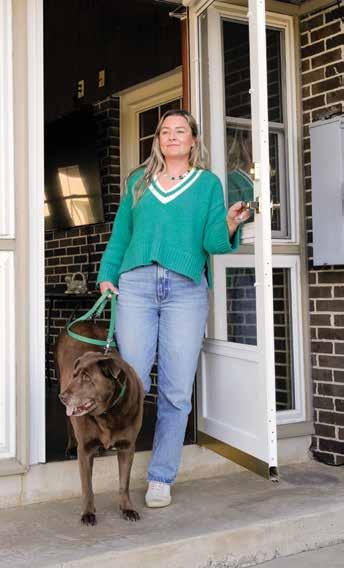 Use weatherstripping in your home to seal air leaks around movable building components, such as doors or operable windows. energy.gov/energysaver/weatherstripping
Use weatherstripping in your home to seal air leaks around movable building components, such as doors or operable windows. energy.gov/energysaver/weatherstripping

he was seldom seen without an apron and seldom seen not working. She was a farmer. Forever. And even when she didn’t live near fields and barns, she was a farmer still, in her heart. She mentored many and inspired far more. A little grandson followed her, closer than her shadow. He learned her love of plants and gardens—it was far more caught than taught. He’d quote her homespun adages, like scriptures learned in church. Some were rather humorous, like when he’d say, with serious tone: “My grandma says she knows she’ll never go to hell, because the devil knows she builds a better fire,” or “I don’t need to rest, I can sleep when I’m dead!” As this grandson grew in stature, he still loved the things she loved. With spades and trowels as his artist’s tools, he created lovely gardens. He learned the proper names of every plant he planted—good friends should have good names. He’d learned from his aproned grandma which plants chose sunny spots and which preferred the shade. He knew when each would be awake and bring their brightest flowers, so he’d plant his gardens in such a way that some would always be in bloom.
This grandma’s boy went off to school, to Michigan State one day. And there he chose to study plants and gardens and propagation. He’d learn his grandma’s favorites had Latin names as well. He’d graduate with honors, assisting his professors. He’d later maintain gardens at the Edsel Ford estate and land a job he’d hold for years, growing perennials for Wiegand’s Nursery. His grandmother moved to heaven—she tends the gardens there. But Gary Bopp, without an apron, continues her gardening here. Retired, he now spends his summers in Lewiston, a rare jewel in northern Michigan. He lives in a place called Bliss Cottage, surrounded by Bliss Gardens. He still propagates perennials, knows each by name, knows each one’s game. He sells them each Saturday morning at Lewiston’s Farmers’ Market. He’s become a local consultant, inspiring the love of the garden. He loves to know his green “children” find
good homes with his neighbors and friends. He likes to imagine he might be a part of making this world more beautiful—spreading awe and fueling wonder in gardens. Last year he propagated 5,000 perennials, tough tested by Lewiston’s climate. He watches with pride as they’re carried from the market to gardens nearby. And somewhere in heaven, an angel with an apron worn over her robe looks down and tells those around her, “I taught him all that he knows.”
“When some people leave this world,” Gary reflects, “they leave a grand monument, a vast estate, or a collection of tributes, awards, and accolades. I hope to leave a garden.”
About the author: Rik Cryderman is happily retired after a 35-year career as director of pastoral care for Beaumont Hospital in Troy, Michigan. He splits his time between Lewiston, Michigan, and Naples, Florida, enjoying grandchildren, gardening, travel, photography, and writing. Fueled by his faith and inspired by his friends, he finds each of life’s chapters better than the last.
Guest Column
Win $200 for stories published!
Share your fondest memories and stories. Win $200 for stories published. Visit countrylines.com/community to submit.
Mystery Photo

Win a $100 energy bill credit!

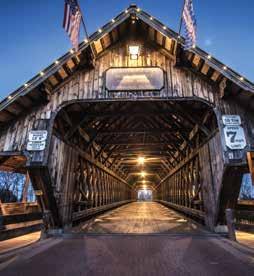
Identify the correct location of the photo to the left by July 24 and be entered into a drawing to win a $100 electric bill credit. Enter your guess at countrylines.com/community









May 2023 Winner! Our Mystery Photo winner is Michelle Cockey, a Midwest Energy & Communications Cooperative member, who correctly identified the photo as the memorial plaque of Ryerson and Melissa Whiting at Whiting Park in Charlevoix County. Winners are announced in the following issues of Country Lines: January, March, May, July/August, September, and November/December.














HEAT EXHAUSTION
OR
Faint or dizzy
Excessive sweating
Cool, pale, clammy skin
Nausea or vomiting
Rapid, weak pulse
Muscle cramps
• Get to a cooler, air-conditioned place
• Drink water if fully conscious
• Take cool shower or use cold compresses
Throbbing headache, confusion
No sweating
Body temperature above 103°
Red, hot, dry skin
Nausea or vomiting
Rapid, strong pulse
May lose consciousness
CALL 911
• Move person to cooler place
• Cool using cloths or bath
• Do not give anything to drink Source: weather.gov